- GRADIENT FILL
- The printing/computer graphics term that may be used when a charge, or a flag's field,
is composed of two or more different colours that gradually merge into each other – fountain fill.
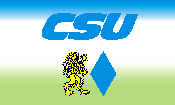


Flag of the Christlich-Soziale Union, Bavaria, Germany
(fotw); Flag of Lista di Pietro - Italia dei Valori (fotw); Flag of L'Ulivo, Italy (fotw)
Please note that a gradient fill is not found in heraldry and is very
rarely employed in classic flag design, but may be seen on some modern (particularly commercial
and especially printed) flags.
- GRADIATED STRIPES
- See ‘optical proportions’.
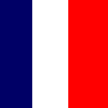
Current Presidential Flag of France (fotw)
- GRAND (or GREAT) QUARTER
- The alternative heraldic terms used to describe that section of a shield or banner of arms that is further subdivided
by being impaled or quartered, and generally employed when one or more sets of quartered, quarterly or impaled
arms are displayed with another either so divided or otherwise - a great quarter (see also ‘impaled’,
‘quarter’, ‘quartered’,
‘quartering’, ‘quarterly’
and ‘shield’).


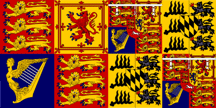
Arms of HM King William III 1689 – 1702, UK (fotw);
Standard of HM Queen Adelaide 1830 – 1849, UK (fotw);
Standard of HM Queen Mary of Teck 1867 – 1953, UK (fotw)
- GRAND UNION
- See ‘continental colors’.
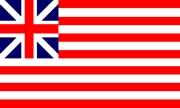
Grand Union/Continental Colours 1775 – 1777, US (fotw)
- GRAND-DUCAL CORONET
- See ‘coronet 2)’.

Lesser Arms of the Grand Duchy of Luxembourg (fotw)
- GRAPEVINE CROSS
- see 'St. Nino's cross'

Flag of Ninotsminda, Georgia (fotw)
- GRAVE DECORATION FLAG
- see 'memorial flag'
- GREAT BANNER
- The term, now obsolete, for a banner showing all the quarterings of a deceased
person's coat of arms for use at that person's funeral (see also
‘achievement of arms 2)’,
‘badge banner’,
‘banner 1)’,
‘banner of arms’, ‘bannerole’,
‘coat of arms 2)’,
‘grumphion’, ‘quartering’
and ‘livery banner’).

Great Banner/Royal Standard of HM King Philip V d1743, Spain (fotw)
Please note that according to English heraldry the sizes of a
great banner were originally as follows: that of an Emperor; six feet square, a King; five
feet square. a Prince or Duke; four feet square, a Marquis, Earl, Viscount, Baron, and
Knight-baronet; three feet square.
- GREAT STANDARD
- A term, now obsolete, for the Scottish heraldic standard as flown from a fixed
staff, and there are indications that it was the largest of three sizes (see also
‘battle standard’, ‘heraldic standard
2)’, and
‘pageant standard’).
![[Great Standard]](../images/v/vxt-d1488.gif)
Standard of the Laird of Clan Arbuthnott (The Flag Center)
- GREAT STAR FLAGS (or GREAT LUMINARY PATTERN)
- The terms used for those US national flags whose canton shows the stars
arranged in the form of a single larger star, and in civilian use
(particularly – but not exclusively - upon merchant vessels) from 1818 until
c1865 - the great luminary pattern (see also ‘Betsy Ross flag’,
‘continental colours’,
‘eagle standard’,
‘Franklin flag’,
‘old glory’,
‘quincunx’,
‘star-spangled banner’ and
‘stars and stripes’).
![[Great Star flag]](../images/v/vxt-d420b.gif)
![[Great Star flag]](../images/v/vxt-d420c.gif)
![[Great Luminary Pattern]](../images/v/vxt-d1232.gif)
Great Star Patterns of
26,
33 and 34 Stars (1837, 1859 and 1861), US (fotw)
- GREAT UNION
- 1) In UK usage, the pattern of Union Flag displayed by military colours and
originally authorized on 30 August 1900 (see also
‘colour 2)’,
‘colours 2)’ and
‘union jack 1)’).
- 2) In US usage, a term referring to the 1775 pattern of national flag and
occasionally used in place of grand union or continental colours – see
‘continental colours’.

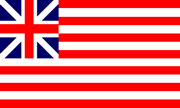
The Great Union, UK (Martin Grieve); The Great/Grand Union 1775, US (fotw)
Please note with regard to 1) that this was an attempt to revive the pattern of
union flag originally authorised in 1800, in that the white and red saltires are of
even width with a fimbriation added, however, the fimbriation to the cross of St
George was (due to an error in reading the blazon) mistakenly designed as too narrow.

Union flag as authorized in 1800, UK (Željko Heimer)
- GREATER ARMS
- See under ‘arms’.
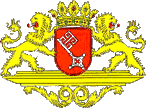
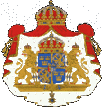
Greater Arms of Bremen, Germany and of
Sweden (fotw)
- GREEK CROSS
- 1) In vexillology the term for a cross whose four arms are straight-sided and of equal length, and which
may, or may not, extend to edges of the flag, panel or canton it occupies (see also
‘acorn cross’ and
‘balkenkreuz’).
2) In heraldry as above – but see ‘cross-couped’
and ‘cross humetty’ (also ‘couped
2)’)
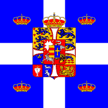

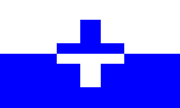
Royal standard c1938, Greece (fotw);
Flag of Unterägeri, Switzerland (fotw);
Flag of Iż-Żurrieq, Malta (fotw)
- GREEN FLAG
- 1) In UK usage the flag awarded to parks and other green spaces that have reached a national standard of excellence
(see also ‘blue flag’).
2) In European usage (including the UK) the flag awarded to schools for reaching established goals in environmental education.
![[Green Flag]](../images/v/vxt-d2806.gif)
![[Green Flag]](../images/v/vxt-d3262.gif)
![[Green Flag]](../images/v/vxt-d3263.gif)
Green Flag Award flag, UK;
Basic Design and Portuguese Variant (fotw and Official Website)
- GRIDIRON
- A heraldic term for the cooking implement upon which St Lawrence was traditionally martyred, and often associated with him – a grill
(see also ‘latticed’).
![[gridiron]](../images/v/vxt-d3004.gif)
![[gridiron]](../images/v/vxt-d3005a.gif)
![[gridiron]](../images/v/vxt-d4373.gif)
Flag of Villars le Grand, Switzerland (fotw): Arms of
Kocierzew Południowy, Poland (fotw);
Flag of Alvelos, Portugal (fotw)
- GRIDIRON FLAG
- In UK usage a term, now obsolete, for the red and white striped flag of the Honourable
East India Company (see also ‘continental
colours’,
‘ensign’,
‘jack’ and
‘red ensign’).
![[HEIC flag]](../images/v/vxt-d584.gif)
![[England]](../images/v/vxt-d584a.gif)
![[United Kingdom]](../images/v/vxt-d584b.gif)
HEIC Flags, England c1600–1707; UK 1707–1801; UK 1801-1864 (fotw)
Notes
a) This flag was introduced as an ensign c1600 and worn as such outside home waters from c1676–1824, after which it was flown as a jack by vessels of the Bombay Marine until 1863.
b)
Thirteen is the usual number of stripes shown, but that nine or
eleven are occasionally seen in contemporary flag books.
c) Information suggests the existence of a gridiron flag bearing a Cross of St
George overall (as illustrated below), and that it was worn by armed vessels of the HIEC,
however, no further details can be confirmed at this present time.
-
![[HEIC flag]](../images/v/vxt-d584c.gif)
Flag of the HIEC bearing a
Cross of St George c1820 (fotw)
- GRIFFIN (or GRYPHON)
- A (variously detailed) mythological creature that is part lion and part eagle, and which
appears as a supporter or as a charge in a set of armorial bearings, on a banner of arms or a flag
- gryphon (see also Appendix V’,
‘armorial bearings’,
‘coat of arms’,
‘heraldic beasts’,
‘phoenix’ and
‘supporters’).
![[griffin example]](../images/v/vxt-d4559.gif)
![[griffin example]](../images/v/vxt-d2173.gif)
![[griffin example]](../images/v/vxt-d2174.gif)
Flag of Rodalben, Germany (fotw); Flag of
Troms, Norway (fotw); Flag of
Gryfice, Poland (fotw)
- GRILL
- In heraldry see ‘gridiron’.
![[grill]](../images/v/vxt-d3008a.gif)
![[grill]](../images/v/vxt-d3008.gif)
Arms and Flag of Jaraczewo, Poland (fotw)
- GRINDSTONE (GRINDWHEEL or GRIND-WHEEL)
- See ‘millstone’ and the note
below.
![[grindstone]](../images/v/vxt-d4383.gif)
![[grindstone]](../images/v/vxt-d4560.gif)
Arms and Flag of Pedra Furada, Portugal
(fotw)
Please note that a grindstone can also be the wheel upon which knives etc. are sharpened, and that such an implement has not - as far as
can be confirmed - yet appeared on flags.
- GROMMET
- 1) A hole or eyelet, reinforced by stitching or an inserted metal ring, usually
found at both ends of the heading on the hoist of a flag, through which clips,
attached to the halyard pass - see ‘Inglefield clip’
(also ‘Appendix I’,
‘clip and grommet’,
'hoist 2)',
'tack', and
'halyard').
- 2) See ‘rope grommet’.
Please note with regard to 1) that Lt (later Admiral) Edward Inglefield RN patented this system in 1890.
- GROMMET AND CLIP
- See ‘clip and grommet’.

Željko Heimer
- GROUND
- 1) In vexillology see ‘field 1)’.
- 2) In heraldry see ‘field 2)’.


Flag and Arms of Negoslavci, Croatia (fotw)
- GROUP COMMAND PENNANT
- See ‘command pennant’.
![[Group Command Pennant, Spain]](../images/v/vxt-d461.gif)
Group Command Pennant, Spain (fotw)
- GRUMPHION (or GRUMPHEON)
- A Scottish term, now obsolete, for a small funeral flag bearing a death's
head.











![[Great Star flag]](../images/v/vxt-d420b.gif)
![[Great Star flag]](../images/v/vxt-d420c.gif)
![[Great Luminary Pattern]](../images/v/vxt-d1232.gif)





![[Green Flag]](../images/v/vxt-d2806.gif)
![[Green Flag]](../images/v/vxt-d3262.gif)
![[Green Flag]](../images/v/vxt-d3263.gif)
![[gridiron]](../images/v/vxt-d3004.gif)
![[gridiron]](../images/v/vxt-d3005a.gif)
![[gridiron]](../images/v/vxt-d4373.gif)
![[HEIC flag]](../images/v/vxt-d584.gif)
![[England]](../images/v/vxt-d584a.gif)
![[United Kingdom]](../images/v/vxt-d584b.gif)
![[HEIC flag]](../images/v/vxt-d584c.gif)
![[griffin example]](../images/v/vxt-d4559.gif)
![[griffin example]](../images/v/vxt-d2173.gif)
![[griffin example]](../images/v/vxt-d2174.gif)
![[grill]](../images/v/vxt-d3008a.gif)
![[grill]](../images/v/vxt-d3008.gif)
![[grindstone]](../images/v/vxt-d4383.gif)
![[grindstone]](../images/v/vxt-d4560.gif)


![[Group Command Pennant, Spain]](../images/v/vxt-d461.gif)

![[Great Standard]](../images/v/vxt-d1488.gif)



